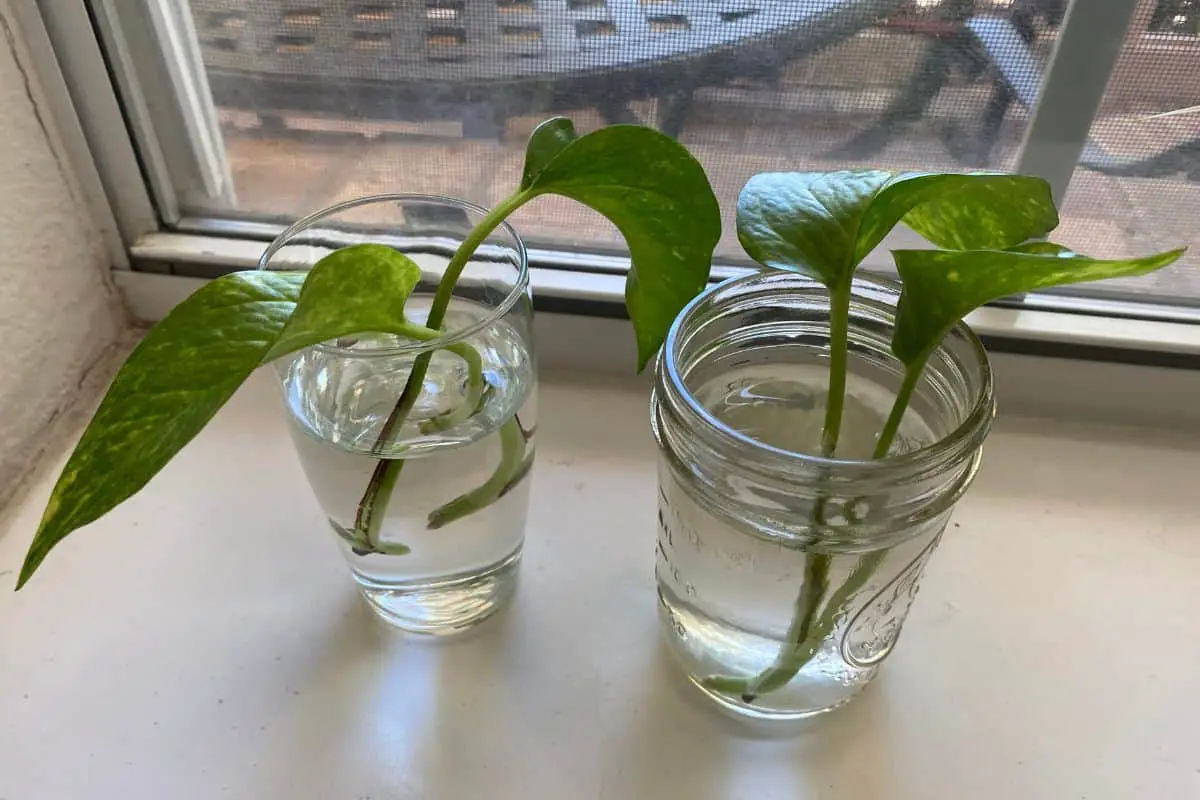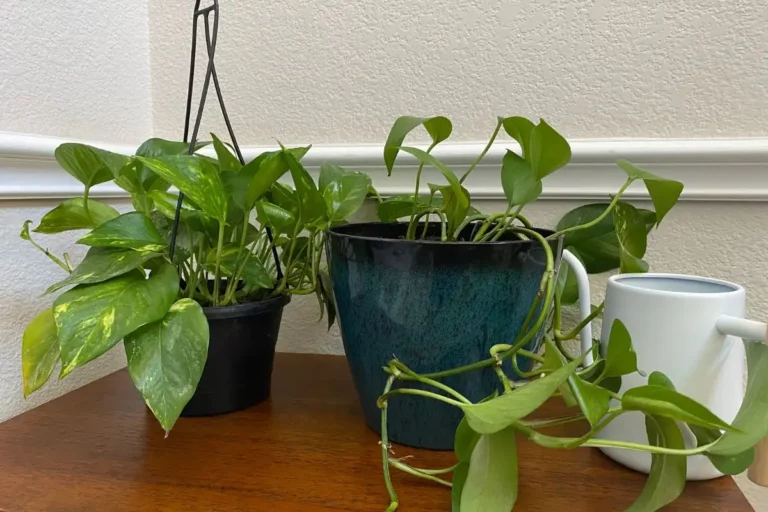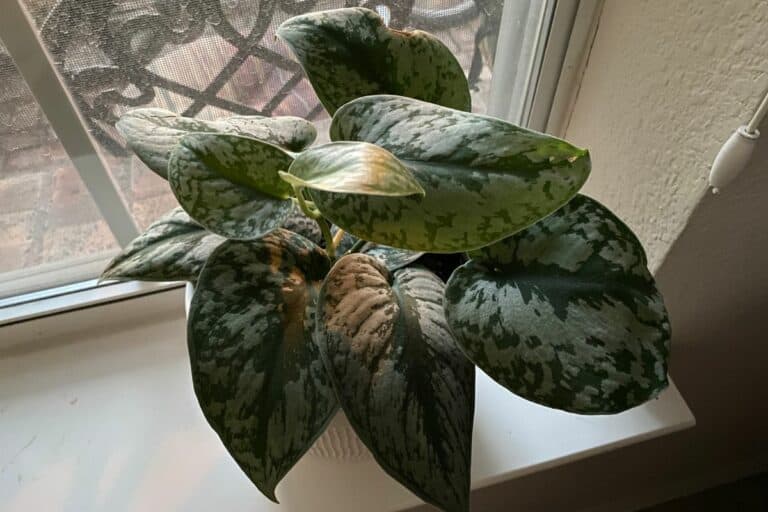Propagating Pothos from a Leaf or Stem: Can You Do It?
Pothos plants have a reputation for being one of the easiest houseplants to care for, and it’s not too hard to see why. They’re relatively low maintenance, and they’re incredibly easy to reproduce if you know what you’re doing.
By properly cutting off a small portion of your plant–then giving that piece of plant the environment and nutrients it needs to develop its own root system–you can make an entirely new pothos plant. This is known as propagation.
But what exactly should you cut off? A piece of stem with several leaves on it? Or just the stem itself? What about leaves: Can you propagate a new plant using just a leaf?
Pothos plants cannot be propagated from leaves alone because leaves are unable to generate their own roots. To best propagate a pothos plant, cut off a piece of stem that includes at least one node and leaf, then submerge the stem in water or moist soil so that the node can grow a new root system.
Sounds easy, right?
Unfortunately, I know from personal experience just how gangly and unshapely a pothos plant can get if you’re not careful about when, where, and how you select your cuttings.
This article will cover several related topics. Please feel free to read everything if this is your first time propagating pothos plants or skip to the section you’d like to learn more about:
- Propagating Pothos 101: Leaves, Stems, Nodes, and Roots
- Can a Pothos Leaf Root in Water?
- Can You Propagate a Pothos Stem Without Any Leaves?
- Propagating Pothos Plants: Step-by-Step Instructions
If you do propagation right, you’ll have more full, lovely-looking pothos than you know what to do with. If you do it wrong, you’ll be left with thin, scraggly-looking houseplants.
The last thing I want is for your houseplants to look thin and scraggly, so if you’re interested in growing the best plants possible, take a look at my in-depth descriptions and recommendations below for tips on how to propagate pothos like a pro.
Propagating Pothos 101: Leaves, Stems, Nodes, and Roots
Before we get into why exactly you can’t propagate a pothos from a single leaf—and what exactly you can do to propagate and grow beautiful houseplants—let’s pause for a moment to take a closer look at propagation.
If you’ve never done it before, you might be wondering: What is propagation anyway?
Propagation refers to the purposeful breeding or reproduction of a parent plant to create new plants. I don’t want to get too scientific, but when we’re discussing the propagation of a pothos houseplant, we’re talking about asexual, vegetative reproduction. This means the new pothos will be an exact clone of the parent plant, created by removing a stem cutting from the original pothos and allowing it to root out and slowly create its own new plant.
Here’s a super simple way to describe the process: Cut off a section of your plant’s stem that contains a node, stick the stem in water or a potting medium, wait a month or so while the node develops a new root system, then pot it and care for it like you would any other pothos houseplant.
This might sound super simple, but if you’ve never done it before, you’ll find that it’s easy to make mistakes along the way, as I did after I purchased my first pothos. Let’s look at these steps in more detail, so you don’t repeat the same mistakes I made.
Simply put, your pothos plant consists of leaves, stems, nodes, and roots. Everyone knows what a leaf, stem, and root look like, but what are nodes?
A node is a junction that’ll produce a new leaf or root as the plant ages. With pothos, nodes will look like little brownish bumps along the plant’s stem, but each one of those bumps has the ability to grow into much more than a bump. When exposed to moisture, the nodes will recognize an opportunity to root and transform themselves from a bump into a fledgling root system.
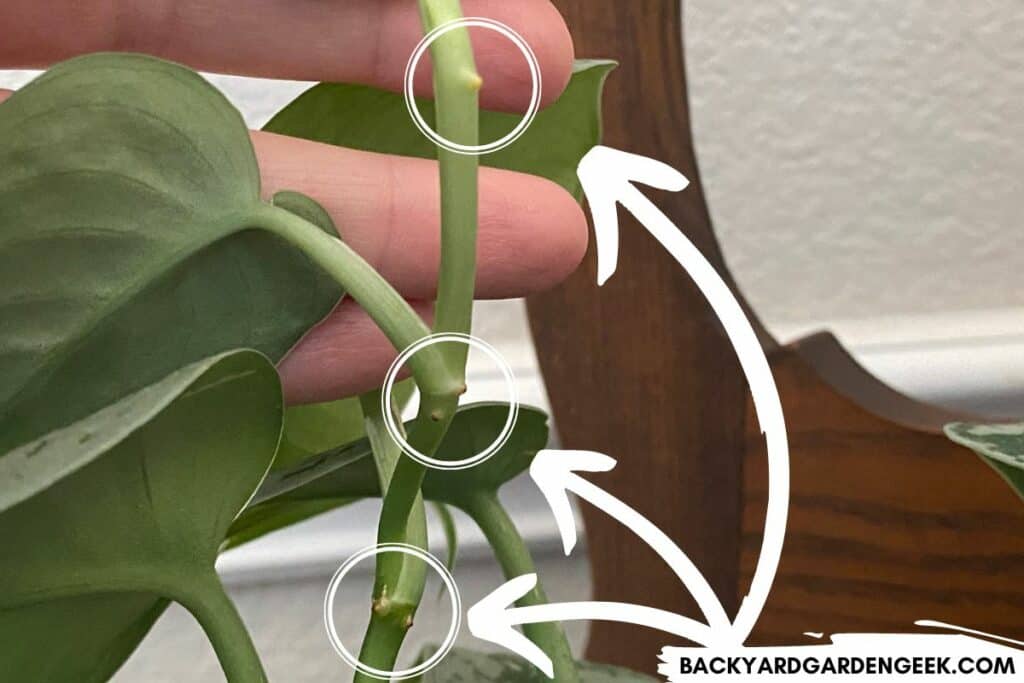
In the wild, this is not only a backup system of sorts–since it’ll protect a pothos if part of the plant is rooted up and damaged–but it’s also a way for plants to grow along the surface of the ground or climb nearby trees, putting out roots through each node that comes into contact with either soil or tree bark and thus expanding the plant’s ability to siphon nutrients out of the ground or surrounding vegetation.
But in each of these scenarios, it’s the node of the plant that does the work, not the leaves.
So what about those leaves? What actually happens if you put one in water? And if you’ve got a piece of stem that has a node on it but no leaves, can you propagate it?
Can a Pothos Leaf Root in Water?
Leaves can be used to propagate certain plant varieties such as succulents and snake plants since those leaves have the ability to generate new roots, but the leaves of pothos plants can’t propagate new plants.
If you cut off a leaf from a pothos plant and attempt to root it in water, all you’re going to get is a dead, rotting leaf. You’ve got to have at least 1 node for successful propagation.

If a pothos leaf has at least one attached stem and node, it’ll propagate it in water. Simply place the cutting in a jar or vase of lukewarm tap water, making sure the node is submerged. Since tap water often contains chlorine, the water will provide a sanitary growing environment for a new cutting.
Place the jar in a location that gets plenty of bright, indirect sunlight and replace the water every day or two. Try not to let the water get too cloudy.
In about 4-6 weeks, the plant’s roots will 1-2 inches long (2.5-5 cm), and your pothos cutting will be ready for potting.
Now let’s take a look at what’ll happen if you attempt to propagate a piece of stem that has a node but no attached leaf.
Can You Propagate a Pothos Stem Without Any Leaves?
Have you ever seen a pothos plant that’s mostly stem with only a few leaves here and there? That’s known as a “leggy” plant, and if your pothos plant has gotten leggy, it’s time to take several cuttings and propagate new plants.
Unfortunately, doing so with a leggy plant often means that you’ll have several cuttings that have nodes but no leaves. Will they propagate?
As long as there is at least one node attached to the stem, you can propagate a new pothos plant, even using stems that don’t have any leaves at all. Doing so isn’t ideal, but the method for propagation is exactly the same whether your cutting has leaves or not.
Propagating a pothos cutting without leaves will take longer for the plant to develop and require more time and attention on your part, but it’ll produce a new plant if you’re patient enough to let it do its work.

For instance, you’ve got to prop up the stem in such a way that its node always has access to water without the stem ever getting fully submerged. To do so, you’ve got to find a way to prop up the stem cutting when it’s in a glass of water since there are no leaves to keep it only partially submerged in water.
Now that you know what exactly happens when you attempt to propagate different parts of a pothos plant, I’d like to break down the propagation process into a few simple steps so that you know exactly what to do and when to do it.
Propagating Pothos Plants: Step-by-Step Instructions
If you’ve got a pothos that’s become leggy or vine-like, now’s the perfect time to trim it back and propagate your cuttings.
First, you’ll want to find a section of stem that has a few leaves growing from it. You should see a node near the junction of each leaf. Using clean shears, cut off about 4-6 inches (10-15 cm) of stem just below the node and ideally at a slight angle.
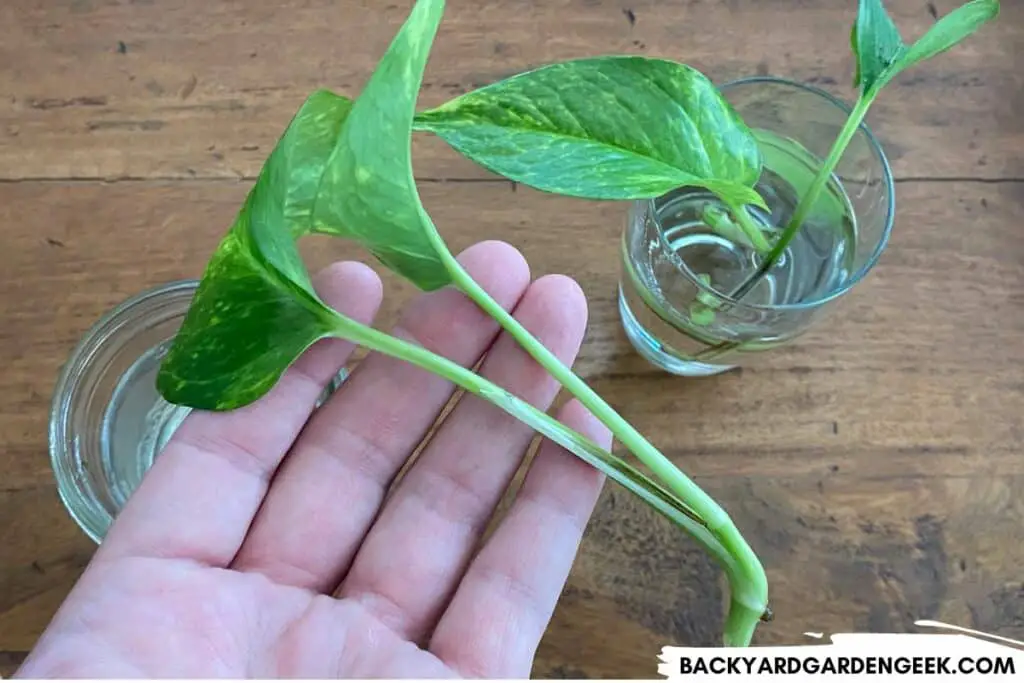
Second, choose a propagation method. You can either propagate your plant in water, use a potting soil, or put your plants in a 50/50 mix of peat moss and perlite.
To propagate your pothos in water, fill a small clear jar or vase with warm tap water. I prefer using mason jars, but you can use whatever you have on hand. Place up to 4 cuttings in the jar, making sure the nodes are fully submerged, and change the water out every 1-2 days to ensure a clean growing environment.
In about four weeks, or when the roots are 1-2 inches long (2.5-5 cm), you can plant your newly-rooted pothos cutting in a smallish. To get a fuller-looking pothos, choose a slightly larger pot and plant 4-6 rooted cuttings. I prefer bushy pothos plants, so I plant as many cuttings as possible, leaving just enough space between each cutting for maximum density.

If you’re planning to propagate your pothos directly in soil or another potting medium, I recommend sterilizing your pots and tools with a mixture of 1 part bleach and 9 parts water. This will ensure that there’s no bacteria in the pot that might harm your plant over time. After sterilizing everything and filling the pot with my soil or potting mix, water everything until it’s moist but not soaked.
Next, you’ll need to use a dibbler, the bottom of a fat sharpie, or your finger to create a hole in the soil. Dip the tip of your cutting in a rooting hormone and then place your cutting in the hole and bury almost up to the leaf. You can propagate several cuttings in the same pot as long as they are about 2 inches apart (5 cm).
Just to be clear, you don’t need a rooting hormone to propagate pothos plants, but it’s helpful to use if you happen to have some.
Finally, keep your cuttings moist so that their root systems don’t dry out.
I’ve heard that some people cover their pots with a plastic bag to create a greenhouse effect, and you can certainly do that if you’re concerned about your soil drying out. Personally, I prefer to do a quick check each day with my moisture meter to make sure the moisture levels are where they should be.
When you notice new growth appearing, that’s a good sign that your pothos has rooted. This usually takes 4-6 weeks.
One word of warning: These recommendations are for indoor houseplants. If you’ve got a pothos that resides in a greenhouse or a covered porch or patio area, I’d encourage you to wait until early spring to collect cuttings and root new plants. Pothos can survive winter with the right care and attention, but you don’t want to stress your plants right before cold weather arrives.
So how do you choose which way to propagate?
As a general rule, water propagation is faster (and I would argue easier), but it tends to produce weaker roots, at least initially. This means your plant will need some extra time to acclimate to the soil once it’s potted and will take a little longer to begin flourishing. However, in time it’ll look just as great as a pothos that you’ve propagated in soil.
Although propagating pothos directly in soil will require more time and attention at the beginning of the process than propagating in water, I generally prefer this method because it produces stronger roots and doesn’t require transplanting to another container. Just be sure to keep the soil moist or else you might damage the cutting’s fragile roots.
As you can see, once you know what you’re doing, propagating pothos plants can be quite simple. Clip off a bit of stem with a leaf and node attached, add it to some water or potting mix, and care for it patiently over the next 4-6 weeks.
If you do that, you’ll have the start of a new, healthy pothos plant. Happy propagating!
